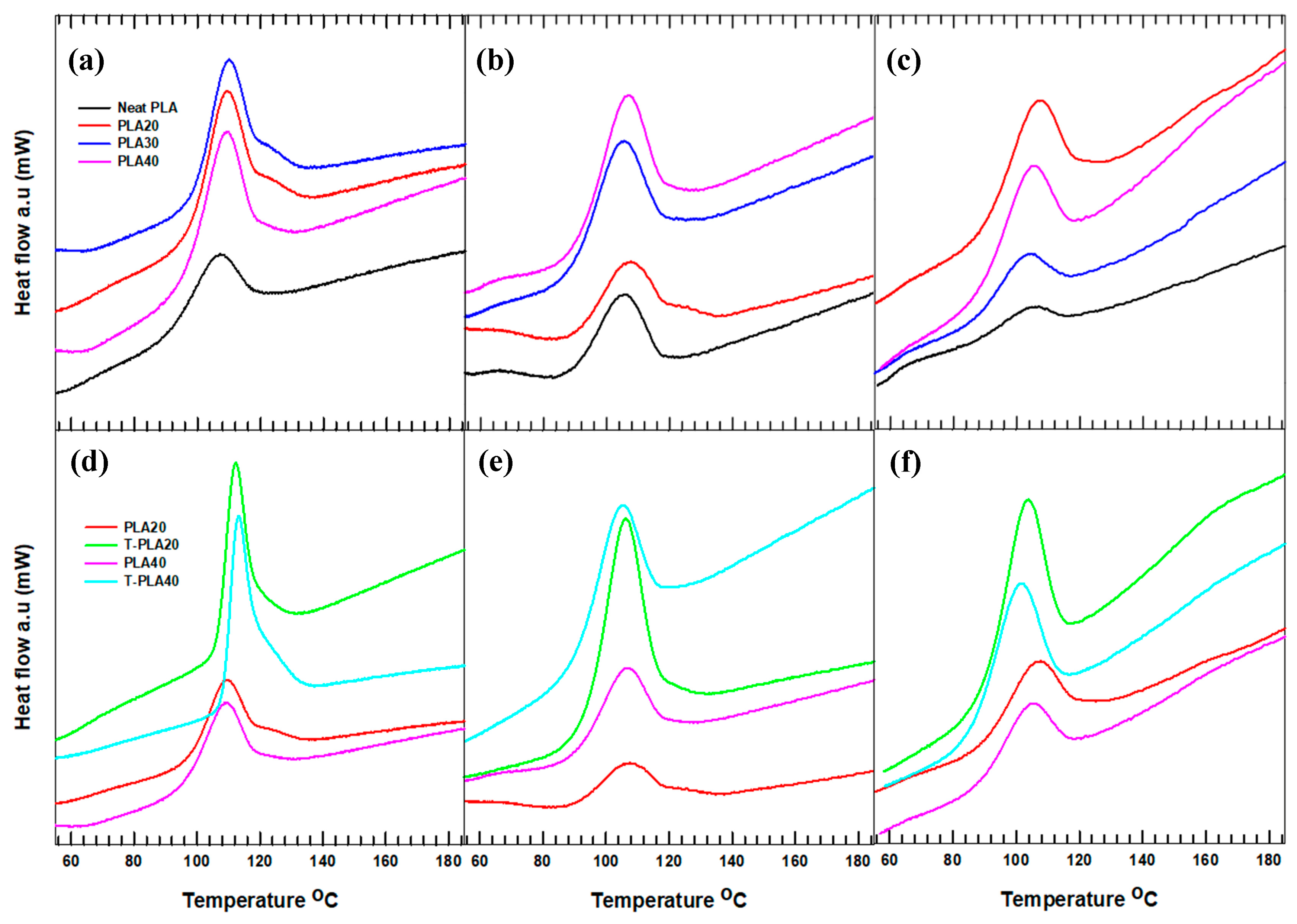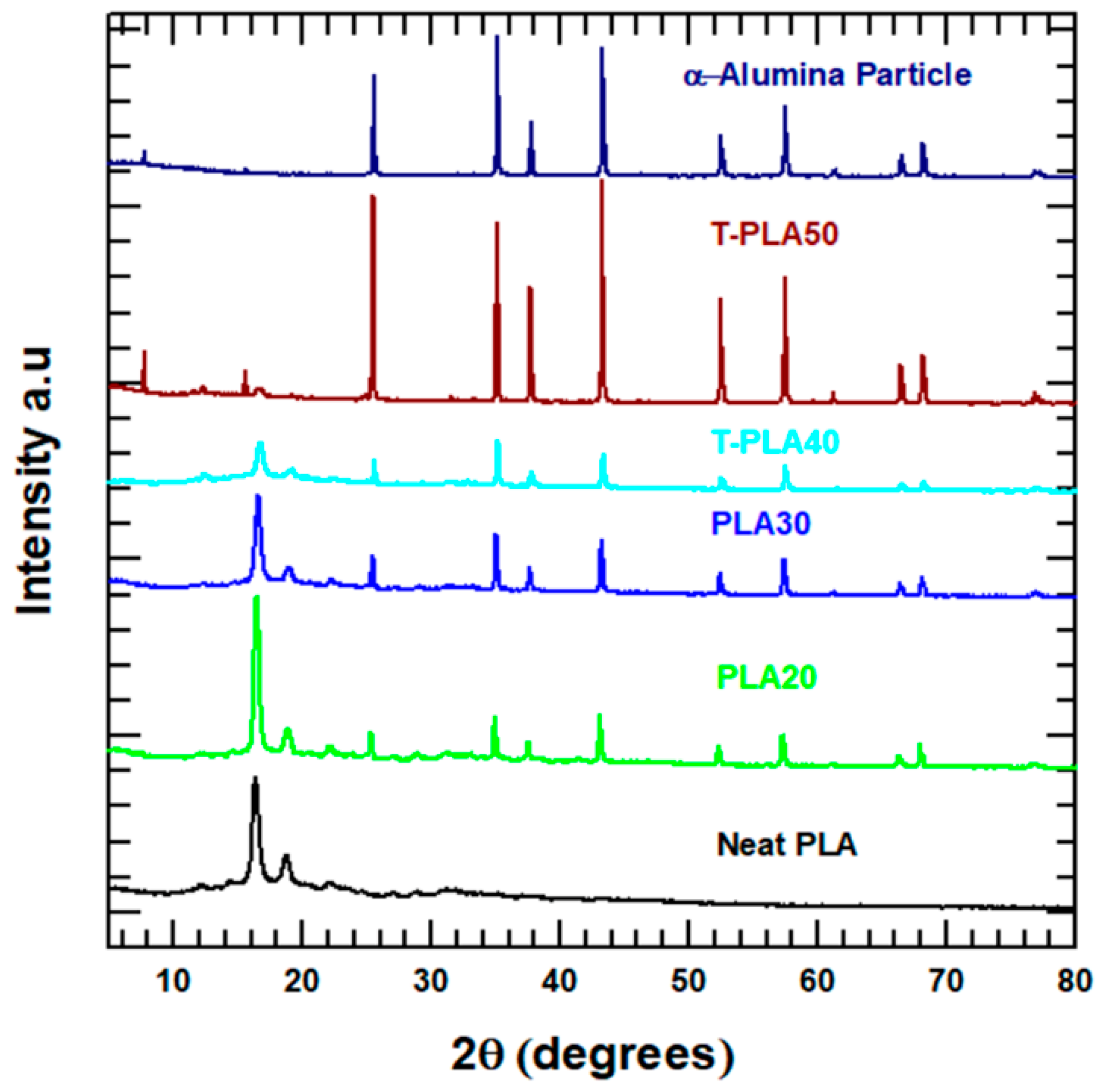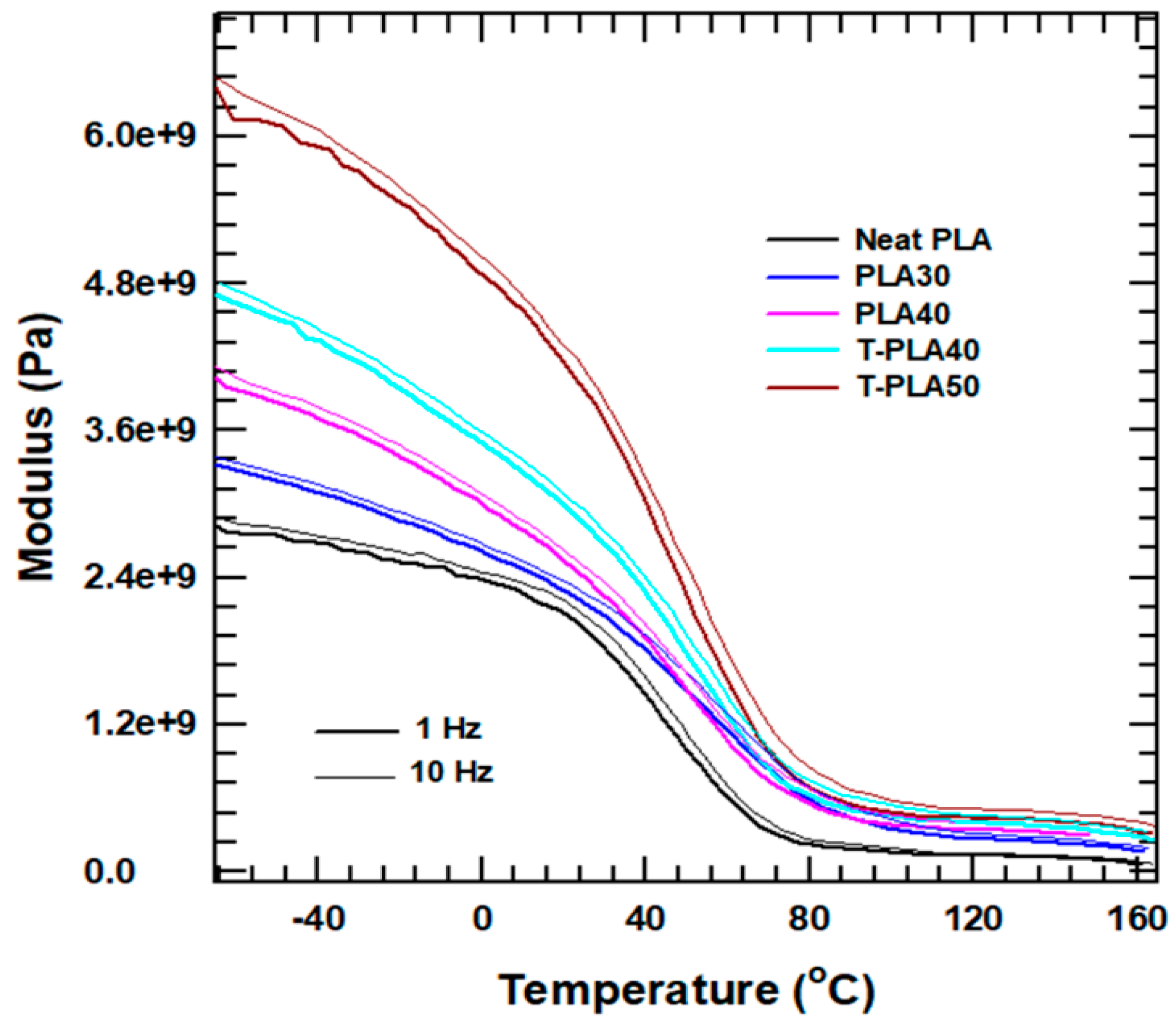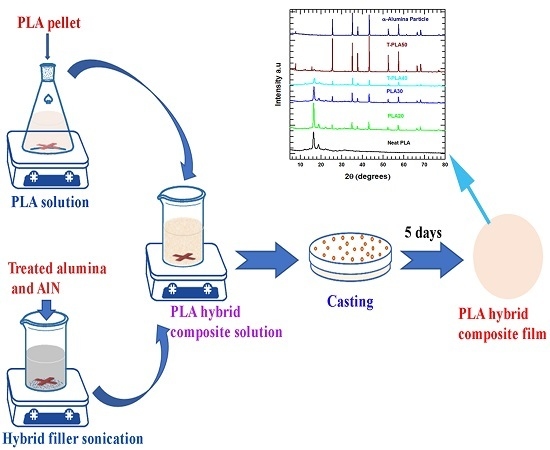Nonisothermal Crystallization of Surface-Treated Alumina and Aluminum Nitride-Filled Polylactic Acid Hybrid Composites
Abstract
1. Introduction
2. Experimental
2.1. Filler Surface Treatment
2.2. PLA Hybrid Composite Fabrication
3. Characterization
4. Results and Discussion
4.1. Surface Characterization
4.2. Nonisothermal Melt and Crystallization Behavior
4.2.1. Crystallization Behavior
4.2.2. Melting and Cold-Crystallization Properties
4.3. Nonisothermal Crystallization Kinetics
4.4. XRD Analysis
4.5. Dynamic Mechanical Properties
5. Conclusions
Supplementary Materials
Author Contributions
Funding
Conflicts of Interest
References
- Yin, H.Y.; Wei, X.F.; Bao, R.Y.; Dong, Q.X.; Liu, Z.Y.; Yang, W.; Xie, B.H.; Yang, M.B. Enantiomeric poly(d-lactide) with a higher melting point served as a significant nucleating agent for poly(l-lactide). CrystEngComm 2015, 17, 4334–4342. [Google Scholar] [CrossRef]
- Park, S.H.; Lee, S.G.; Kim, S.H. Isothermal crystallization behavior and mechanical properties of polylactide/carbon nanotube nanocomposites. Compos. Part A Appl. Sci. Manuf. 2013, 46, 11–18. [Google Scholar] [CrossRef]
- Auras, R.; Harte, B.; Selke, S. An overview of polylactides as packaging materials. Macromol. Biosci. 2004, 4, 835–864. [Google Scholar] [CrossRef] [PubMed]
- Shi, X.; Zhang, G.; Phuong, T.V.; Lazzeri, A. Synergistic effects of nucleating agents and plasticizers on the crystallization behavior of Poly(lactic acid). Molecules 2015, 20, 1579–1593. [Google Scholar] [CrossRef] [PubMed]
- Chen, H.M.; Zhang, W.B.; Du, X.C.; Yang, J.H.; Zhang, N.; Huang, T.; Wang, Y. Crystallization kinetics and melting behaviors of poly(l-lactide)/graphene oxides composites. Thermochim. Acta 2013, 566, 57–70. [Google Scholar] [CrossRef]
- Chen, H.; Chen, J.; Chen, J.; Yang, J.; Huang, T.; Zhang, N.; Wang, Y. Effect of organic montmorillonite on cold crystallization and hydrolytic degradation of poly(L-lactide). Polym. Degrad. Stab. 2012, 97, 2273–2283. [Google Scholar] [CrossRef]
- Hwang, J.-J.; Huang, S.-M.; Liu, H.-J.; Chu, H.-C.; Lin, L.-H.; Chung, C.-S. Crystallization kinetics of poly (L-lactic acid)/montmorillonite nanocomposites under isothermal crystallization condition. J. Appl. Polym. Sci. 2012, 124, 2216–2226. [Google Scholar] [CrossRef]
- Huang, J.-W.; Chang Hung, Y.; Wen, Y.-L.; Kang, C.-C.; Yeh, M.-Y. Polylactide/nano- and micro-scale silica composite films. II. Melting behavior and cold crystallization. J. Appl. Polym. Sci. 2009, 112, 3149–3156. [Google Scholar] [CrossRef]
- Shi, N.; Dou, Q. Non-isothermal cold crystallization kinetics of poly(lactic acid)/poly(butylene adipate-co-terephthalate)/treated calcium carbonate composites. J. Therm. Anal. Calorim. 2015, 119, 635–642. [Google Scholar] [CrossRef]
- Bhimaraj, P.; Yang, H.; Siegel, R.W.; Schadler, L.S. Crystal nucleation and growth in poly(ethylene terephthalate)/alumina-nanoparticle composites. J. Appl. Polym. Sci. 2007, 106, 4233–4240. [Google Scholar] [CrossRef]
- Terzopoulou, Z.; Klonos, P.A.; Kyritsis, A.; Tziolas, A.; Avgeropoulos, A.; Papageorgiou, G.Z.; Bikiaris, D.N. Interfacial interactions, crystallization and molecular mobility in nanocomposites of Poly(lactic acid) filled with new hybrid inclusions based on graphene oxide and silica nanoparticles. Polymer (Guildf). 2019, 166, 1–12. [Google Scholar] [CrossRef]
- Xiao, H.; Yang, L.; Ren, X.; Jiang, T.; Yeh, J.-T. Kinetics and crystal structure of poly(lactic acid) crystallized nonisothermally: Effect of plasticizer and nucleating agent. Polym. Compos. 2010, 31, 2057–2068. [Google Scholar] [CrossRef]
- Fortunati, E.; Armentano, I.; Zhou, Q.; Puglia, D.; Terenzi, A.; Berglund, L.A.; Kenny, J.M. Microstructure and nonisothermal cold crystallization of PLA composites based on silver nanoparticles and nanocrystalline cellulose. Polym. Degrad. Stab. 2012, 97, 2027–2036. [Google Scholar] [CrossRef]
- Li, H.; Cao, Z.; Wu, D.; Tao, G.; Zhong, W.; Zhu, H.; Qiu, P.; Liu, C. Crystallisation, mechanical properties and rheological behaviour of PLA composites reinforced by surface modified microcrystalline cellulose. Plast. Rubber Compos. 2015, 45, 181–187. [Google Scholar] [CrossRef]
- Lule, Z.; Ju, H.; Kim, J. Effect of surface-modified Al2O3on the thermomechanical properties of polybutylene succinate/Al2O3composites. Ceram. Int. 2018, 44, 13530–13537. [Google Scholar] [CrossRef]
- Kuo, M.C.; Huang, J.C.; Chen, M. Non-isothermal crystallization kinetic behavior of alumina nanoparticle filled poly(ether ether ketone). Mater. Chem. Phys. 2006, 99, 258–268. [Google Scholar] [CrossRef]
- Mosavian, M.T.H.; Sahebian, S.; Bakhtiari, A. Non-Isothermal Crystallization of Al2O3/HDPE Composite. Polym. Plast. Technol. Eng. 2011, 50, 225–231. [Google Scholar] [CrossRef]
- Lule, Z.; Kim, J. Surface Modification of Aluminum Nitride to Fabricate Thermally Conductive poly(Butylene Succinate) Nanocomposite. Polymers (Basel). 2019, 11, 148. [Google Scholar] [CrossRef]
- Lule, Z.; Ju, H.; Kim, J. Thermomechanical properties of alumina-filled plasticized polylactic acid: Effect of alumina loading percentage. Ceram. Int. 2018, 44, 22767–22776. [Google Scholar] [CrossRef]
- Mao, Y.; Fung, B.M. Formation and characterization of anchored polymer coatings on alumina. Chem. Mater. 1998, 10, 509–517. [Google Scholar] [CrossRef]
- Battegazzore, D.; Bocchini, S.; Frache, A. Crystallization kinetics of poly(lactic acid)-talc composites. Express Polym. Lett. 2011, 5, 849–858. [Google Scholar] [CrossRef]
- Ledwa, K.A.; Kępiński, L. Dispersion of ceria nanoparticles on γ-alumina surface functionalized using long chain carboxylic acids. Appl. Surf. Sci. 2017, 400, 212–219. [Google Scholar] [CrossRef]
- Zhou, S.; Zheng, X.; Yu, X.; Wang, J.; Weng, J.; Li, X.; Feng, B.; Yin, M. Hydrogen bonding interaction of poly(D,L-lactide)/hydroxyapatite nanocomposites. Chem. Mater. 2007, 19, 247–253. [Google Scholar] [CrossRef]
- Füllbrandt, M.; Purohit, P.J.; Schönhals, A. Combined FTIR and dielectric investigation of poly(vinyl acetate) adsorbed on silica particles. Macromolecules 2013, 46, 4626–4632. [Google Scholar] [CrossRef]
- Chen, P.; Yu, K.; Wang, Y.; Wang, W.; Zhou, H.; Li, H.; Mi, J.; Wang, X. The Effect of Composite Nucleating Agent on the Crystallization Behavior of Branched Poly (Lactic Acid). J. Polym. Environ. 2018, 26, 3718–3730. [Google Scholar] [CrossRef]
- Naffakh, M.; Marco, C.; Ellis, G. Non-Isothermal cold-crystallization behavior and kinetics of poly(L-lactic acid)/WS2 inorganic nanotube nanocomposites. Polymers (Basel). 2015, 7, 2175–2189. [Google Scholar] [CrossRef]
- Ke, T.; Sun, X. Melting behavior and crystallization kinetics of starch and poly(lactic acid) composites. J. Appl. Polym. Sci. 2003, 89, 1203–1210. [Google Scholar] [CrossRef]
- Sadabadi, H.; Aftabtalab, A.; Zafarian, S.; Shaker, S.; Ahmadipour, M.; Rao, K.V. High purity Alpha Alumina nanoparticle: Synthesis and characterization. Int. J. Sci. Eng. Res. 2013, 4, 1593–1596. [Google Scholar]
- Zhang, X.; Shi, J.; Ye, H.; Dong, Y.; Zhou, Q. Combined effect of cellulose nanocrystals and poly(butylene succinate) on poly(lactic acid) crystallization: The role of interfacial affinity. Carbohydr. Polym. 2018, 179, 79–85. [Google Scholar] [CrossRef]







| Sample | Composition (wt %) | ||
|---|---|---|---|
| PLA | Alumina | AlN | |
| Neat PLA | 100 | 0 | 0 |
| PLA20 | 80 | 18 | 2 |
| T-PLA20 | 80 | 18 * | 2 |
| PLA30 | 70 | 28 | 2 |
| PLA40 | 60 | 38 | 2 |
| T-PLA40 | 60 | 38 * | 2 |
| T-PLA50 | 50 | 48 * | 2 |
| Sample | ψ (°C/min) | Tc (°C) | Tcc (°C) | ΔHc (J/g) | ΔHm (J/g) | Xc (%) |
|---|---|---|---|---|---|---|
| Neat PLA | 5 | 105.8 | 103.0 | 17.0 | 54.1 | 46.2 |
| 10 | 105.7 | 108.2 | 7.6 | 51.8 | 33.4 | |
| 20 | - | 130.7 | 2.5 | 43.0 | 3.2 | |
| PLA20 | 5 | 109.0 | - | 29.9 | 41.2 | 55.3 |
| 10 | 107.7 | 106.5 | 8.5 | 41.4 | 38.9 | |
| 20 | 106.1 | 114.0 | 11.8 | 37.0 | 21.8 | |
| T-PLA20 | 5 | 112.2 | - | 34.0 | 42.7 | 57.3 |
| 10 | 106.0 | 96.1 | 20.8 | 46.8 | 58.8 | |
| 20 | 103.4 | 102.6 | 19.7 | 43.9 | 49.7 | |
| PLA30 | 5 | 110.0 | - | 29.7 | 37.2 | 57.1 |
| 10 | 104.8 | 104.7 | 9.3 | 40.8 | 47.2 | |
| 20 | 103.4 | 114.1 | 5.2 | 31.3 | 9.8 | |
| PLA40 | 5 | 108.6 | 95.7 | 24.2 | 29.3 | 52.5 |
| 10 | 105.8 | 105.8 | 10.0 | 37.8 | 47.1 | |
| 20 | 104.5 | 114.4 | 7.9 | 32.1 | 20.1 | |
| T-PLA40 | 5 | 111.2 | - | 23.6 | 41.3 | 71.1 |
| 10 | 104.7 | 92.5 | 18.1 | 34.0 | 58.9 | |
| 20 | 101.0 | 98.2 | 17.6 | 40.5 | 58.3 | |
| T-PLA50 | 5 | 112.3 | - | 29.3 | 34.2 | 73.5 |
| 10 | 106.5 | 91.6 | 13.6 | 28.7 | 56.9 | |
| 20 | 102.5 | 102.3 | 21.5 | 36.5 | 67.3 |
| Sample | N | k (10−3) | kc (10−3) | |||||||
|---|---|---|---|---|---|---|---|---|---|---|
| Ψ | 5 | 10 | 20 | 5 | 10 | 20 | 5 | 10 | 20 | |
| Neat PLA | 2.56 | 2.72 | 2.49 | 10 | 262 | 159.1 | 401 | 875 | 102.3 | |
| PLA20 | 2.49 | 2.71 | 2.56 | 15 | 66 | 841 | 433 | 763 | 991 | |
| T-PLA20 | 2.72 | 3.92 | 2.85 | 15 | 25 | 142.5 | 432 | 691 | 101.8 | |
| PLA30 | 2.54 | 2.63 | 3.4 | 10 | 171 | 369 | 394 | 838 | 951 | |
| PLA40 | 2.90 | 2.64 | 2.63 | 5 | 113 | 107.8 | 342 | 804 | 100.4 | |
| T-PLA40 | 3.04 | 2.77 | 2.60 | 5 | 114 | 142.2 | 341 | 805 | 101.8 | |
| T-PLA50 | 2.73 | 2.63 | 3.04 | 13 | 304 | 985 | 422 | 888 | 999 | |
© 2019 by the authors. Licensee MDPI, Basel, Switzerland. This article is an open access article distributed under the terms and conditions of the Creative Commons Attribution (CC BY) license (http://creativecommons.org/licenses/by/4.0/).
Share and Cite
Lule, Z.; Kim, J. Nonisothermal Crystallization of Surface-Treated Alumina and Aluminum Nitride-Filled Polylactic Acid Hybrid Composites. Polymers 2019, 11, 1077. https://doi.org/10.3390/polym11061077
Lule Z, Kim J. Nonisothermal Crystallization of Surface-Treated Alumina and Aluminum Nitride-Filled Polylactic Acid Hybrid Composites. Polymers. 2019; 11(6):1077. https://doi.org/10.3390/polym11061077
Chicago/Turabian StyleLule, Zelalem, and Jooheon Kim. 2019. "Nonisothermal Crystallization of Surface-Treated Alumina and Aluminum Nitride-Filled Polylactic Acid Hybrid Composites" Polymers 11, no. 6: 1077. https://doi.org/10.3390/polym11061077
APA StyleLule, Z., & Kim, J. (2019). Nonisothermal Crystallization of Surface-Treated Alumina and Aluminum Nitride-Filled Polylactic Acid Hybrid Composites. Polymers, 11(6), 1077. https://doi.org/10.3390/polym11061077







